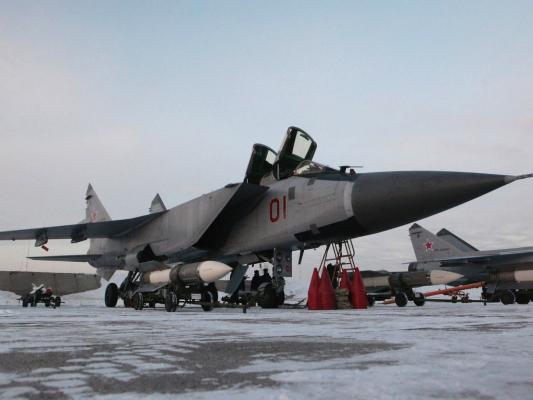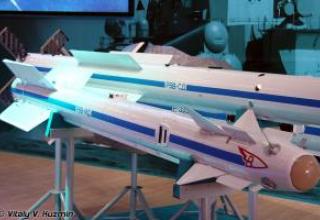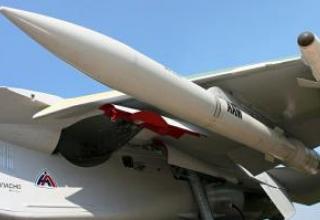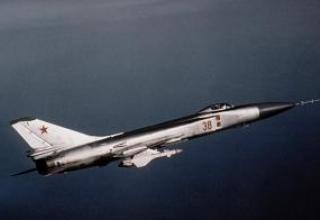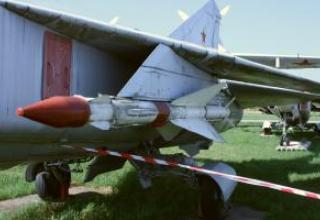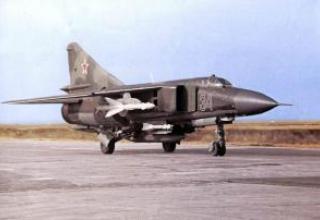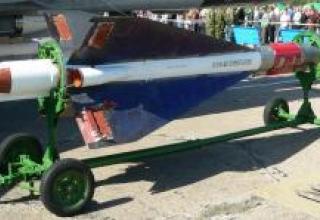The R-37 long-range guided missile (K-37, RVV-BD) is designed to engage air targets (fighters, attack aircraft, bombers, military transport aircraft, helicopters, cruise missiles) at any time of the day, from all angles, in conditions of electronic counteraction, against the background of the earth and water surface, including multi-channel firing on the principle of "let's forget".
The development of the K-37 missile (item 610) for the arms of the MiG-31M interceptor based on the K-33 missile was initiated by the State Design Bureau "Vympel" by the USSR Council of Ministers on April 8, 1983. The first flight of the MiG-31M prototype (serial number 05-01-01) took place on December 21, 1985. Tests of K-37 began in 1988 with autonomous ballistic missile launches without a control system (10 launches). In 1989, the tests involved program missiles without guidance system (4 launches) - flying under the control of autopilot program.
In the same 1989 started tests of missiles with guidance system (2 launches). In April 1994, an air target was successfully hit at a record range of 304 km. Tests of the missile continued until 1997. After 1997 in connection with infringement of cooperation with the enterprises of Ukraine which have been involved in creation of guidance systems of the rocket, the decision on development of guidance system with use only Russian components was accepted. MiG-31M with K-37 missile was presented at the International Aviation and Space Salon MAKS-1997 (see photo1, photo2, photo3, photo4, photo5, photo6, photo7, photo8), the Russian Air Force was not accepted for service.
The obtained grounding was used to create an aircraft intercepting complex for the MiG-31BM fighter-interceptor. The modified rocket, made of Russian components, received the designation K-37M (product 610M). Under the designation of RVV-BD (item 620), the missile has been repeatedly exhibited at exhibitions of military equipment.
The most important improvement, compared to the previous version, is the use of the new MFBU-610MSh control system for the K-37M. K-37M guided missiles (item 610M) were first launched with the MiG-31 in 2011 and completed state trials in 2014. The missile is currently manufactured by KTRV Corporation in Korolev, the production of the onboard control system has been entrusted to the Ural Design and Engineering Bureau "Detail".
The MiG-31BM is equipped with a new weapons control system and a radar station. The upgraded weapon control system RP-31MA "Zaslon-AM" (S-800AM) with radar 8BM received a new computer "Baguette-55-06" instead of "Argon-15A". The passive antenna with electronic beam control remained unchanged. The detection range of the upgraded radar station is 320 km, automatic tracking - 280 km (fighter detection range - 240 km). 24 targets are simultaneously escorted, of which 6 are simultaneously firing missiles (in the previous version - 10 and 4 respectively). The 8TK heater remained unchanged.
In the front cabin some mechanical devices were replaced by a liquid crystal display, 127x127 mm, located on the right side of the instrument panel. Operator's cabin (rear) received two large 152x203 mm LCD display instead of electron beam tubes. The aircraft received new communication equipment (P800L radio station) and improved radio navigation equipment, including A737 satellite navigation system. From the wing disappeared large pylons for weapons (previously predesigned for missiles R-40TD), which were replaced by hangers sufficient for missiles R-77-1 or R-73. In addition, it is now possible to place air-to-air missiles on the external points of suspension, previously used only for additional fuel tanks. The MiG-31BM is slightly heavier than version "B" - the maximum takeoff weight is 46835 kg, and the flight data has not changed much, except for the ceiling, which has dropped to slightly over 20,000 m.
Mass production of the airborne missile began in 2014. In the west, the missile was designated AA-X-13 Arrow.
Composition:
The K-37 missile is designed according to the normal aerodynamic scheme with a small wing of elongation (see the scheme). Stabilizers are in a folded position before launch. The guidance system is inertial, with radiocorrection and active radar homing on the final section of the flight path.
Four K-37M are suspended in two pairs one after another under the fuselage of the MiG-31BM. At launch, the rocket first with the help of catapult installation AKU-410-1 is thrown down from the aircraft, and then starts a dual-mode solid propellant engine.
The missile K-37 (product 610) was equipped with a radar homing head GSN 9B-1388 / MFBU-610/. 9B-1388 was developed by Research Institute "Agat" and serially produced by Ryazan radio plant. The diameter of SL 9B-1388 is 380 mm, weight - 40 kg, range of radiocorrection (from the carrier) - up to 100 km, range of target acquisition with the area of 5m2 active radar SL 9B-1388 - 40 km.
The K37M missile (RVV-BD, product 610M) is equipped with a new advanced active radar SLN 9B-1103M-350 developed by JSC Research Institute "Agat" (see description).
GSN 9B-1103M-350 provides:
- searching, capturing and escorting air targets,
- receiving and decoding radiocorrection signals,
- formation and transmission of signals over a digital communication line to control the missile.
Mode of operation :
- Fully autonomous (active) mode by pre-targeting without radar support in flight (the "let-forget" mode),
- radio-corrected inertial guidance mode,
- reprogramming mode.
According to the published materials, the maximum launch range of the airborne airborne radar escort sample into the PPS for some types of targets is 200 km.
The combat unit is a shrapnel-flagged one. Explosive device - radar active non-contact and contact target sensors. The missile is equipped with a dual-mode solid propellant engine.
The RVV-BD, compared to the K-37, has a shortened head compartment with a radio-transparent fairing of a new shape. The length of the RVV-BD is 140 mm shorter than that of the K-37.
Suspension of the RVV-BD missile on the carrier, power supply in flight, tactical launch and emergency reset is carried out using an aircraft catapult device AKU-410-1 (AKU-620). When placed on a carrier, unlike the K-37, only the upper stabilizer rudders are added to the RVV-BD.
The designated service life is 8 years. The designated service life of the missile is 50 flight hours with an unlimited number of takeoffs and landings with concrete coating (20 takeoffs and landings with ground and metal coating). Continuous operation time of the equipment in flight under the carrier aircraft - 3 hours. Serviceability of onboard equipment of the rocket at operation is checked annually on a complex of preparation of aircraft destruction means "Oka-E" or on control equipment "Oka-620".
The Airborne Breakout System includes the following types of training and training missiles:
- RVV-BD-UD is a training and operational missile for ground training of technical personnel in rules of preparing missiles for use, storage, transportation and operation;
- RVD-BD-UL is a training and flight missile for training flight personnel in operations involving the combat use of missiles without actual launches;
- RVV-BD-UL - a training and cutting missile to study the flight and technical composition of the missile system;
- RVV-BD-GM - a dimensional model of the rocket to assess the TTH of the aircraft carrier with missiles on a suspension.
Characteristics:
| RVV-BD | |
| Maximum launch range at BCPs for some types of targets, km | 200 (300 for К37М) |
| Minimum launch range, km | 3.7 |
| Height of targets, km | 0.015-25 |
| Overload of affected targets, g | 8 |
| Starter weight, kg | до 510 |
| Targeting angles, deg | ±60 |
| Weight of combat unit, kg | 60 |
| Length, m | 4.06 |
| Diameter, m | 0.38 |
| Wingspan, m | 0.72 |
| Wheelspan, m | 1.02 |
Testing:
From September 1 to November 28, 1945, the Nb.W.42 trophy mortar was tested at the Red Army State Automobile and Space Administration. The tests were carried out on the basis of the order of the Deputy Chief of SAKP, Major-General of the Engineering and Artillery Service of Serebryakov under the program of the range - SAKP task №4410.
In the report No 0116 dated 19.1.46 the description of the device and operation of the Wgr.42 mine, L.J.gr.Z23nA fuse and the mortar were given. Data on the heap and range, as well as theoretical calculations of internal and external ballistics are given. In addition, the report contains the results of analysis of the hull materials and equipment. The test manager was Captain Lerner.
The purpose of the tests was to determine:
- basic characteristics of the mortar and the mine Wgr.42 /description of the device, operation and purpose/.
- Intraballistic characteristics Wgr.42 /powder gas pressure and charge burn time/.
- aerodynamic characteristics Wgr.42 (wind tunnel blowing).
- The impact and maximum mine speed and the nature of mine buildup in the active area.
- Maximum range at 10°, 20°, 30° and 45° elevation angles.
- The mine's blast and fragmentation effect on the target.
- the system's strength, stability and rate of fire.
When measuring five minutes on centering belts, the projectile caliber was 214 mm, so the report suggested "counting the caliber not 210 mm as usual, but 214 mm".
The conclusions of report No. 0116 were as follows:
- The 210 mm Wgr.42 rocket projectile with the M-13UK missile was characterized by simplicity, cheapness and availability of materials that were used for its production. It was noted that the Germans considered it possible for missile chambers to allow deformation at maximum pressure beyond the elastic limits, i.e. the chambers were calculated not on the elastic limit, but on the temporary resistance to rupture with a margin of strength of the order n=1.5.
- Manufacturing of dinitroglycol powders for rocket charges had advantage in comparison with manufacturing of nitroglycerine powders. As glycol was based on cheap raw material base (vegetable oils), and glycerin was mainly produced from animal fats.
During the study of the mine, it was disassembled into structural elements. See their photos: photo 1, photo 2, photo 3, photo 4, photo 5, photo 6, photo 7.
From August 8th till August 13th 1945 at the State Mine Stockpile of Ukraine there were conducted shooting to determine experimental data for drawing up tables of shooting. Shots were fired at an elevation angle of 10°, 20°, 30° and 45° (maximum possible elevation angle).
The mortar was simultaneously loaded with 5 shells. The mortar was fired in single shots. The charge was corrected after each shot, and the shoot down rate was insignificant. Due to lack of German mortar sight, side aiming was made with MP-41 sight.
As a result of tests it was received:
- The puchiness and range of the 210 mm Wgr.42 missile did not differ from the characteristics of the domestic M-13UK projectile. When the angle of Ө decreases (elevation angle) the heap drops sharply especially in range: gri Ө=10° the range of 2650m and the WDX = 1/17 was obtained; WDX = 1/58, at Ө=45° the range of 8000 m and the WDX = 1/88; WDX = 1/76.
- The effect of the Wgr.42 mine on the target was undoubtedly more powerful than that of the M-13UK, as the 210mm projectile carried 9.27 kg of explosives, while the M-13UK carried 4.55 kg. However, the Wgr.42 has a smaller fill factor /WB to passive weight ratio than the M-13UK. The M-13UK had a filling ratio of 13% and Wgr.42 had a filling ratio of 10%.
- The design of the Wgr.42 mine was characterized by the simplicity, affordability and accessibility of the materials used in its manufacture.
- Calculation of internal ballistics showed the following results: at charge temperature - 40°C the pressure in the chamber was equal to 106 kg/cm2, at charge temperature +40°C the pressure was equal to 325 kg/cm2. This gave grounds to suppose that the rocket charge will work at low temperatures and will not break the chamber at high ones.
- The chemical composition and physical characteristics of the gunpowder rocket charge did not differ from glycol powders, which were adopted in German artillery. Powder strength and caloric value were of the same order as M-13UK rocket charges, but the use of glycol undoubtedly extended the raw material base of the powder production.
- The design of the 210-mm 5-barrel Nb.W.42 mortar carriage did not differ from that of the 150-mm 6-barrel Nb.W.41 mortar carriage.
- The maneuverability and ease of operation are satisfactory, but the power of the 210 mm mortar salvo is about 1.5 times smaller than that of the BM-13. For one salvo of 5-barrel mortar ejected 46 kg ВВ, and installation BM-13 - 73 kg ВВ.
It was concluded that the design of the 210 mm Nb.W.42 rocket launcher and its projectile was found to be successful, both in combat and operational terms.
The mortar was disassembled into its structural elements during its study. See their photographs: photo 1, photo 2, photo 3, photo 4, photo 5, photo 6, photo 7, photo 8.
Sources:
- «Крылья Родины» 3-4.2018 /http://www.kr-magazine.ru /
- Ракета РВВ-БД
- Усовершенствованная АРГС 9Б-1103М-350 /" ОАО МНИИ «Агат»"/
- Авиационная ракета класса "воздух-воздух" большой дальности РВВ-БД /"Бастион"/
- МАКС-2013 : Средства связи и навигации, вооружение, ГСН и двигатели /Vitaly V Kuzmin/
- Ерохин Е. Управляемая авиационная ракета класса "воздух-воздух" большой дальности РВВ-БД /missiles.ru/
- Ангельский Р., Коровин В. Отечественные управляемые ракеты "воздух-воздух" // Техника и вооружение. №9 / 2005 г.
- Дмитриев А., Перспективы военной авиации. // Независимое военное обозрение. № 22 / 1997 г.
- Ильин В., "Английская гончая" с красными звездами. // Крылья родины. N 2-3 / 1993 г.
- Ильин В., Су-35 - последняя новость.// Техника и оружие. N 1 / 1995 г.
- Марковский В., Перов К., Ракета находит цель.// Крылья Родины. N 9 / 1995 г.
- Никифоров А., Под крылом самолета. // Аэроплан. N 3 / 1993 г.
- Российское ракетное оружие 1943-1993, изд-во "ПИКА", С-Пб, 1993 г.
- К-37 / Р-37 / РВВ-БД - AA-X-13 ARROW /militaryrussia.ru/
- Вестник корпорации ТРВ N 8 за 2015г.

